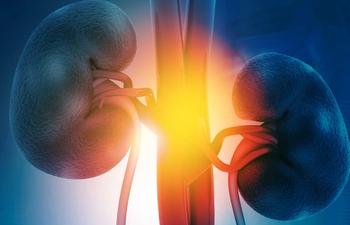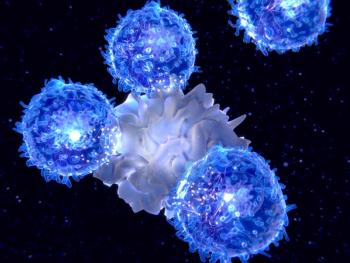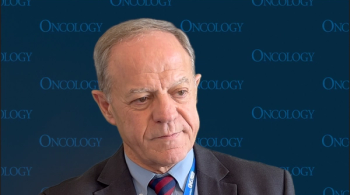
- ONCOLOGY Vol 23 No 7
- Volume 23
- Issue 7
Is There a Role for LHRH Antagonists in Prostate Cancer?
The recent US Food and Drug Administration (FDA) approval of degarelix, a luteinizing hormone-releasing hormone (LHRH) antagonist, has renewed interest in this class of drugs as a prostate cancer therapy. Approval was based on a prospective phase III trial of 610 patients randomized to one of two dosing schedules of degarelix, or standard-of-care monthly leuprolide acetate monotherapy, with initial antiandrogen therapy allowed at the treating physician’s discretion for prevention of clinical flare.[1]
The recent US Food and Drug Administration (FDA) approval of degarelix, a luteinizing hormone-releasing hormone (LHRH) antagonist, has renewed interest in this class of drugs as a prostate cancer therapy. Approval was based on a prospective phase III trial of 610 patients randomized to one of two dosing schedules of degarelix, or standard-of-care monthly leuprolide acetate monotherapy, with initial antiandrogen therapy allowed at the treating physician’s discretion for prevention of clinical flare.[1] The study clearly met its primary endpoint, to demonstrate equivalence of degarelix and leuprolide in suppressing testosterone from 28 to 364 days after initiating therapy. As Crawford and Hou discuss, the primary difference between the two drugs was predictably observed within the first 28 days, in the form of an LHRH agonist–induced testosterone surge not seen with an LHRH antagonist.
Other Approaches Available
The standard of care in the case of impending morbid events complicating hormone-sensitive metastatic prostate cancer (such as obstructive uropathy, hydronephrosis, or spinal cord compression) is to rapidly reduce testosterone measurements to castrate levels to prevent clinical flare. Crawford and Hou argue that LHRH antagonist monotherapy is highly efficacious in this respect. However, the tenet underlying the development of LHRH agonists-that a safe means of rapidly reducing testosterone levels is an unmet need-is not accurate. There are already two approaches available for doing so: surgical castration and adrenolytic agents.
Surgical castration results in castrate testosterone in 3 to 12 hours,[2] faster than any other available therapy. Adrenolytic agents such as the imidazole derivative ketoconazole and the aromatase inhibitor aminoglutethimide suppress both testicular and adrenal steroidogenesis, rapidly reducing testosterone levels to low levels within 48 to 72 hours after initiating therapy,[3] with kinetics similar to degarelix. Ketoconazole competitively inhibits the 17,20-lyase and 17-α-hydroxylase activities comprising CYP17, the rate-limiting enzyme in androgen biosynthesis.[4,5] More potent, irreversible inhibitors of the CYP17 complex are in late-phase prostate cancer clinical trials, and these agents suppress testosterone levels to levels lower than those achievable with modulators of the LHRH axis. In cases where there is no urgent need to rapidly reduce testosterone levels, lead-in oral antiandrogen therapy is sufficient to prevent clinical disease flare and PSA surge seen with LRHR agonist monotherapy.[6]
Despite the authors’ rationale that avoiding a testosterone surge may be beneficial in select patients, no definitive evidence suggests that a more rapid PSA decline results in longer progression-free or overall survival. In fact, recent data suggest that a prolonged time to PSA nadir independently predicts overall survival,[7] suggesting that a more rapid initial PSA velocity in response to rapid pharmacologic castration is not likely to have a major impact on prostate cancer–specific mortality. Furthermore, differences in absolute PSA between LHRH antagonist and agonist treatment arms are nonexistent after 2 months of therapy, and immediately in patients who receive complete androgen blockade (CAB), consistent with the absence of a testosterone surge after CAB.[1] Downstream Biology and Toxicities Crawford and Hou highlight the substantial differences in the downstream biology of LHRH agonists and antagonists. Specifically, LHRH agonists are less effective at suppressing FSH than antagonists, with a surge in LH and FSH followed by a persistence of FSH in patients receiving LHRH agonist therapy at a level 54.8% below baseline vs 89% below baseline in patients receiving degarelix. Notably, however, after 280 days this difference disappeared between the two treatment arms, with FSH levels appearing to slowly rise in degarelix patients. The authors speculate that lower FSH levels could potentially result in decreased osteoclastogenesis and increased bone density, but it remains to be seen whether this is clinically relevant as it was not an endpoint of the phase III trial.[1] Interestingly, patients who undergo orchiectomy have 10-fold higher levels of FSH then those receiving LHRH agonists,[8] with evidence of neither increased skeletal events nor reduced efficacy relative to LHRH agonist monotherapy.
While the safety profiles for LHRH agonists and antagonists were comparable in the phase III trial, there were significant differences between them. Cardiovascular toxicity along with other adverse events were otherwise mostly similar for both drug classes, with the exception of increased arthralgias (P < .05) and urinary tract infections (P < .01) in patients receiving leuprolide. The etiology of these differences is unclear, but tumor flare might have contributed, given that not all patients on the leuprolide arm received lead-in antiandrogen therapy. Historically, this class of drugs has been plagued by systemic allergic reactions, which has been evident since the approval of abarelix in 2003. The drug was essentially abandoned in 2005, following postmarketing studies that demonstrated a 1% incidence of anaphylaxis, with frequency of such reactions increasing with duration of therapy. As a result, ongoing intensive monitoring was required, increasing the cost of administrating abarelix. While no anaphylaxis was observed with degarelix, the researchers reported many more dose-dependent injection site reactions (40% vs < 1% with leuprolide) and chills (4% vs 0%), suggesting the risk of hypersensitivity reactions over time. Like abarelix, degarelix is a synthetic peptide with the potential for increasing antigenicity in the long term. This could be a greater concern when long-acting, high-dose depot preparations are available.
Finally, there is little known about the biochemical events surrounding prolonged therapy and discontinuation of LHRH antagonists. Notably for abarelix, approximately one-third of patients who continued on treatment for 1 year failed to maintain castrate testosterone levels consistent with tachyphylaxis. Crawford and Hou comment that degarelix maintained testosterone suppression for the 1-year duration of the study; however, it is unknown whether this will be true with longer-term treatment. Also, the rate of testosterone recovery from LHRH antagonist therapy is unknown at the present time. To this end, an ongoing phase III open label study is currently examining intermittent therapy comprising 7 months of degarelix (NCT00801242).
Conclusion
In summary, the most salient indication for using LHRH antagonists is when rapid castration is needed. The precise role of LHRH antagonists has yet to be established, but these agents appear to add little therapeutically to existing androgen-deprivation therapies (eg, ketoconazole, CAB, and orchiectomy).
Financial Disclosure:The author has no significant financial interest or other relationship with the manufacturers of any products or providers of any service mentioned in this article.
References:
1. Klotz L, Boccon-Gibod L, Shore ND, et al: The efficacy and safety of degarelix: A 12-month, comparative, randomized, open-label, parallel-group phase III study in patients with prostate cancer. BJU Int 102:1531-1538, 2008.
2. Lin BJ, Chen KK, Chen MT, et al: The time for serum testosterone to reach castrate level after bilateral orchiectomy or oral estrogen in the management of metastatic prostatic cancer. Urology 43:834-837, 1994.
3. Lowe FC, Somers WJ: The use of ketoconazole in the emergency management of disseminated intravascular coagulation due to metastatic prostatic cancer. J Urol 137:1000-1002, 1987.
4. Loose DS, Kan PB, Hirst MA, et al: Ketoconazole blocks adrenal steroidogenesis by inhibiting cytochrome P450-dependent enzymes. J Clin Invest 71:1495-1499, 1983.
5. Gsur A, Bernhofer G, Hinteregger S, et al: A polymorphism in the CYP17 gene is associated with prostate cancer risk. Int J Cancer 87:434-437, 2000.
6. Kotake T, Usami M, Akaza H, et al: Goserelin acetate with or without antiandrogen or estrogen in the treatment of patients with advanced prostate cancer: A multicenter, randomized, controlled trial in Japan. Zoladex Study Group. Jpn J Clin Oncol 29:562-570, 1999.
7. Chung CS, Chen MH, Cullen J, et al: Time to prostate-specific antigen nadir after androgen suppression therapy for postoperative or postradiation PSA failure and risk of prostate cancer-specific mortality. Urology 71:136-140, 2008.
8. Beer TM: Experimental use of GnRH antagonists as second-line hormonal therapy. Rev Urol 6(suppl 7):S33-S38, 2004.
Articles in this issue
over 16 years ago
Prophylactic Central Lymph Node Dissection: Continued Controversyover 16 years ago
Music Therapyover 16 years ago
The Role of LHRH Antagonists in the Treatment of Prostate Cancerover 16 years ago
PARP Inhibitors Show Promise for Hard-to-Treat Breast CancersNewsletter
Stay up to date on recent advances in the multidisciplinary approach to cancer.


















































































